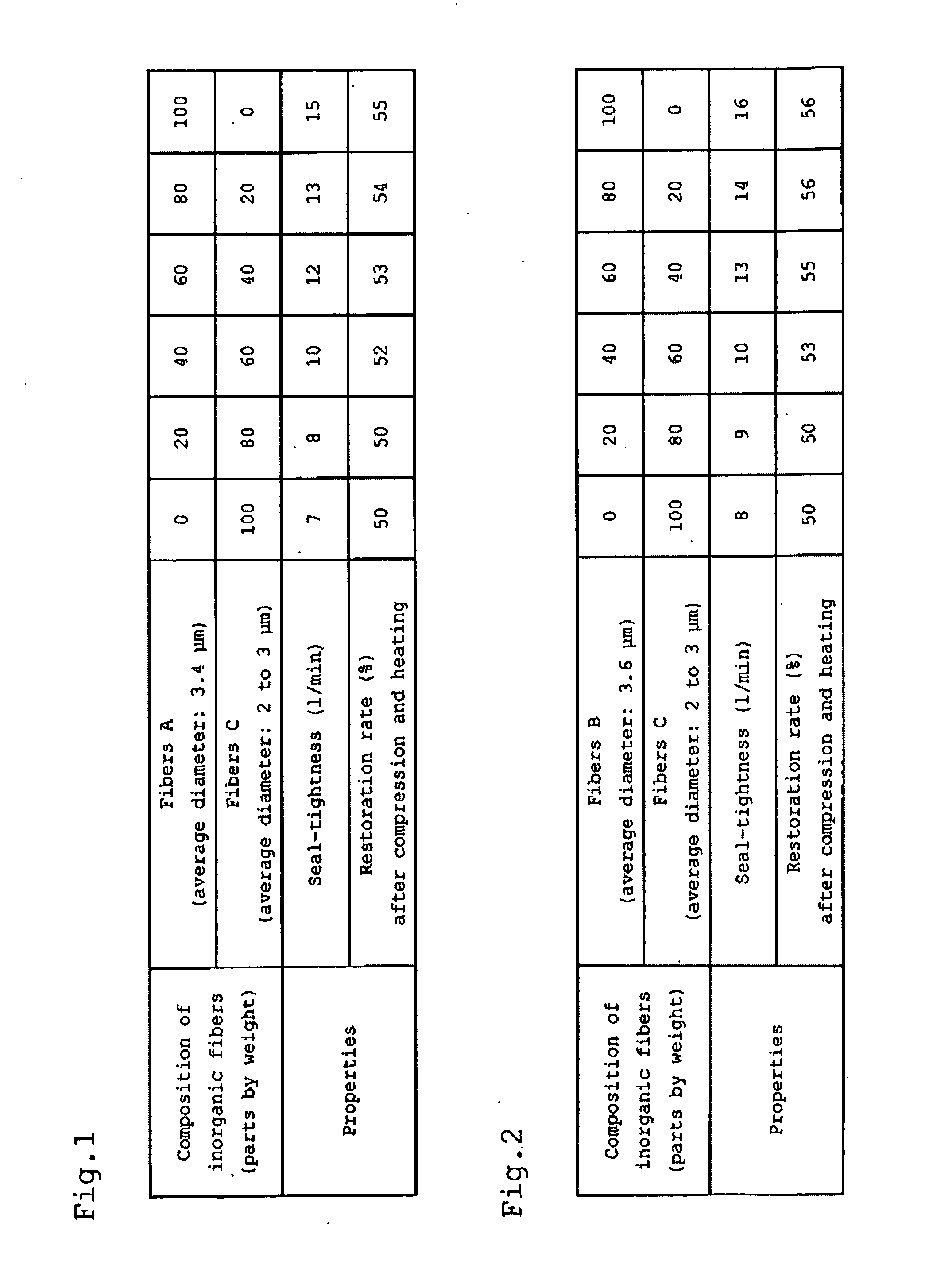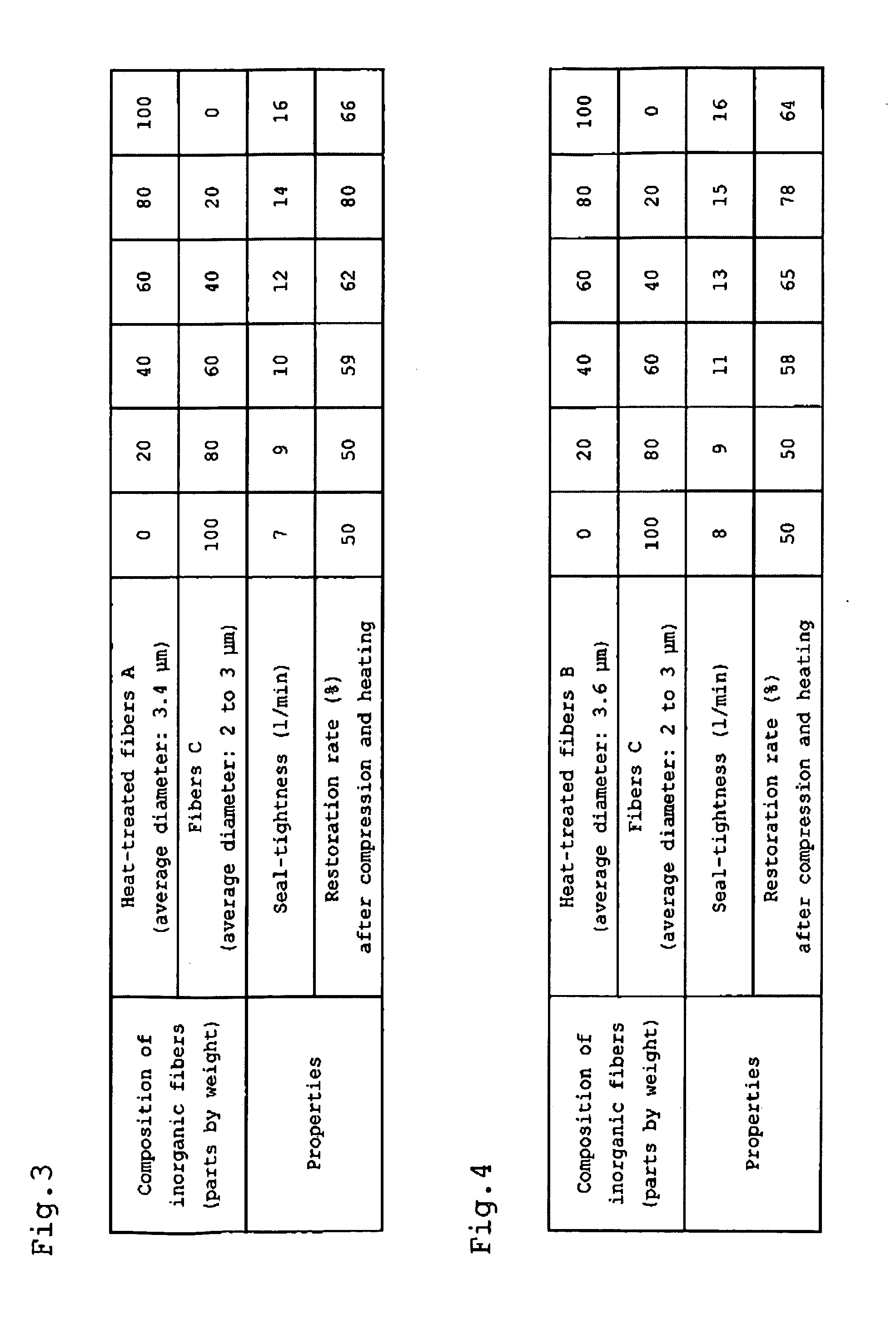Inorganic fiber paper and method of producing the same
a technology paper, which is applied in the field of inorganic fiber paper, can solve the problems that inorganic fiber paper produced using inorganic fibers that exhibit excellent heat resistance and excellent biosolubility may exhibit insufficient seal-tightness, and achieve excellent seal-tightness and excellent seal-tightness
- Summary
- Abstract
- Description
- Claims
- Application Information
AI Technical Summary
Benefits of technology
Problems solved by technology
Method used
Image
Examples
example 1
Production of Inorganic Fiber Paper
[0066]Amorphous SiO2 / CaO fibers having an SiO2 content of 74 mass, a CaO content of 25 mass %, an MgO content of 0.3 mass %, and an Al2O3 content of 2 mass % (hereinafter referred to as “fibers A”) were prepared as the first biosoluble inorganic fibers. The crystallization temperature of the fibers A was 895° C. The average diameter of the fibers A was 3.4 μm.
[0067]Rock wool having an SiO2 content of 90 mass %, a CaO content of 35 mass, an MgO content of 5 mass %, and an Al2O3 content of 13 mass % (hereinafter referred to as “fibers C”) was prepared as the second fibers. The average diameter of the fibers C was 2 to 3 μm.
[0068]Six types of inorganic fiber papers were produced which contain 100 parts by weight of the fibers A and 0 parts by weight of the fibers C, 20 parts by weight of the fibers A and 80 parts by weight of the fibers C, 40 parts by weight of the fibers A and 60 parts by weight of the fibers C, 60 parts by weight of the fibers A and...
example 2
Production of Inorganic Fiber Paper
[0077]Amorphous SiO2 / MgO fibers having an SiO2 content of 76 mass, a CaO content of 4 mass %, an MgO content of 18 mass, and an Al2O3 content of 2 mass % (hereinafter referred to as “fibers B”) were prepared as the first fibers. The crystallization temperature of the fibers B was 857° C. The average diameter of the fibers B was 3.6 μm. The fibers C used in Example 1 were prepared as the second fibers.
[0078]Six types of inorganic fiber papers that differed in the mixing ratio of the fibers B and C (biosoluble inorganic fibers) were produced in the same manner as in Example 1. Each inorganic fiber paper had a thickness of 0.5 to 6 mm, a basis weight of 75 to 1800 g / m2, and a density of 0.15 to 0.3 g / cm3.
Evaluation of Seal-Tightness and Restoration Rate after Compression and Heating
[0079]The seal-tightness and the restoration rate after compression and heating of the inorganic fiber paper were evaluated in the same manner as in Example 1. FIG. 2 shows...
example 3
Production of Inorganic Fiber Paper
[0081]The fibers A that had been heated (hereinafter referred to as “heat-treated fibers A”) were prepared as the first fibers. Specifically, the fibers A used in Example 1 were heated at 800° C., which was a temperature less than the crystallization temperature, for 20 minutes to obtain the heat-treated fibers A. The fibers C used in Example 1 were prepared as the second fibers.
[0082]Six types of inorganic fiber papers that differed in the mixing ratio of the heat-treated fibers A and the fibers C (biosoluble inorganic fibers) were produced in the same manner as in Example 1. Each inorganic fiber paper had a thickness of 0.5 to 6 mm, a basis weight of 75 to 1800 g / m2, and a density of 0.15 to 0.3 g / cm3.
Evaluation of Seal-Tightness and Restoration Rate after Compression and Heating
[0083]The seal-tightness and the restoration rate after compression and heating of the inorganic fiber paper were evaluated in the same manner as in Example 1. FIG. 3 sho...
PUM
| Property | Measurement | Unit |
|---|---|---|
| Temperature | aaaaa | aaaaa |
| Temperature | aaaaa | aaaaa |
| Percent by mass | aaaaa | aaaaa |
Abstract
Description
Claims
Application Information
 Login to View More
Login to View More - R&D
- Intellectual Property
- Life Sciences
- Materials
- Tech Scout
- Unparalleled Data Quality
- Higher Quality Content
- 60% Fewer Hallucinations
Browse by: Latest US Patents, China's latest patents, Technical Efficacy Thesaurus, Application Domain, Technology Topic, Popular Technical Reports.
© 2025 PatSnap. All rights reserved.Legal|Privacy policy|Modern Slavery Act Transparency Statement|Sitemap|About US| Contact US: help@patsnap.com


